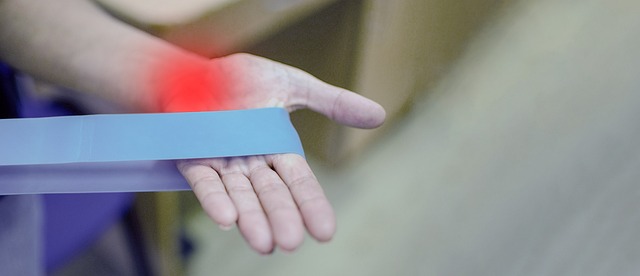Cold and heat therapy for muscle healing is an ancient practice combining modalities like hot baths/saunas with ice packs/cold showers to stimulate blood circulation, reduce inflammation, and promote tissue repair. Heat increases blood flow and relaxes muscles, while cold numbs the area and reduces swelling. Alternating these therapies accelerates recovery, enhances fitness, and benefits both acute injuries and chronic muscle soreness, making it a powerful strategy for optimal muscle well-being.
“Unleash your body’s natural healing potential with a powerful duo: hot and cold therapy. This ancient practice has gained modern scientific backing as an effective approach to muscle recovery. Discover how these contrasting temperatures work synergistically to optimize healing.
From reducing inflammation to enhancing blood circulation, this article explores the science behind cold and heat therapy for muscle healing. We’ll delve into the benefits of each technique and provide insights on combining them for optimal results.”
Understanding Hot and Cold Therapy for Muscle Healing
Hot and cold therapy, also known as thermotherapy, is a powerful tool for muscle healing. This ancient practice leverages the therapeutic effects of temperature changes to stimulate blood circulation, reduce inflammation, and promote tissue repair. By alternating between heat and cold, athletes and individuals recovering from injuries can experience accelerated recovery and improved overall performance.
Heat therapy increases blood flow to the affected area, helping to relax muscles, ease stiffness, and alleviate pain. On the other hand, cold therapy reduces inflammation and numbs the area, providing temporary relief from discomfort. Combining these two modalities—often through methods like hot baths or saunas followed by ice packs or cold showers—can lead to enhanced muscle healing, faster response times, and better overall fitness recovery for athletes and active individuals suffering from muscle soreness or injuries related to physical activity.
The Scientific Basis of Cold Therapy for Inflammation Reduction
The scientific basis behind cold therapy as a strategy for inflammation reduction is rooted in its ability to constrict blood vessels, which helps decrease blood flow to damaged areas. This process, known as vasoconstriction, serves as a protective mechanism for tissues, reducing the influx of inflammatory cells and mediators that can contribute to swelling and pain. By limiting the transmission of these irritants, cold therapy can effectively mitigate inflammation associated with muscle injuries or post-workout soreness.
Additionally, cold exposure triggers a cascade of physiological responses that support muscle healing. It stimulates the release of norepinephrine, a hormone involved in the body’s stress response, which can enhance cellular repair mechanisms. Cold therapy also upregulates the expression of anti-inflammatory genes and promotes the production of heat shock proteins, contributing to the overall recovery process in both acute injuries and chronic conditions, such as persistent muscle soreness.
Heat Therapy: Its Role in Enhancing Blood Circulation and Tissue Repair
Heat therapy plays a crucial role in enhancing blood circulation and tissue repair, which are essential processes for muscle healing. When applied to injured or sore muscles, heat increases blood flow to the affected area. This influx of oxygen-rich blood brings vital nutrients and hormones that promote healing, while also helping to flush out metabolic waste products that can slow down recovery. By improving circulation, heat therapy accelerates the body’s natural repair mechanisms, fostering a more efficient and effective healing process.
Additionally, heat has been shown to relax and dilate blood vessels, further enhancing its benefits for muscle healing. This relaxation reduces vascular resistance, allowing for better delivery of healing substances to damaged tissues. As a result, cold and heat therapy for muscle healing becomes a dynamic duo, offering both immediate pain relief and long-term enhancements in tissue regeneration and overall muscular well-being.
Combining Hot and Cold Therapies: Optimizing the Healing Process
Combining hot and cold therapies is a powerful strategy for optimising the healing process, especially when it comes to muscle recovery. This ancient practice, known as alternation therapy, involves switching between applications of heat and cold on the affected area. By alternating between these two extremes, you can stimulate blood flow in a unique way, which has been proven to reduce inflammation and promote tissue repair.
Heat therapy increases blood circulation, bringing essential nutrients and oxygen to the muscles, while cold therapy helps constrict blood vessels, reducing swelling and numbing the area temporarily. This contrast can accelerate muscle healing by ensuring a steady supply of nutrients for cell regeneration and removing metabolic waste products that may hinder recovery.
Hot and cold therapy, often considered an ancient practice, has gained modern scientific validation as a powerful tool for muscle healing. By understanding the science behind these contrasting treatments, we can optimize our recovery strategies. Cold therapy effectively reduces inflammation, while heat therapy boosts blood circulation and aids tissue repair. Combining both offers a synergistic effect, accelerating the healing process for athletes and fitness enthusiasts alike. Incorporating these therapies into your post-workout routine could be the key to faster and more efficient muscle recovery.
